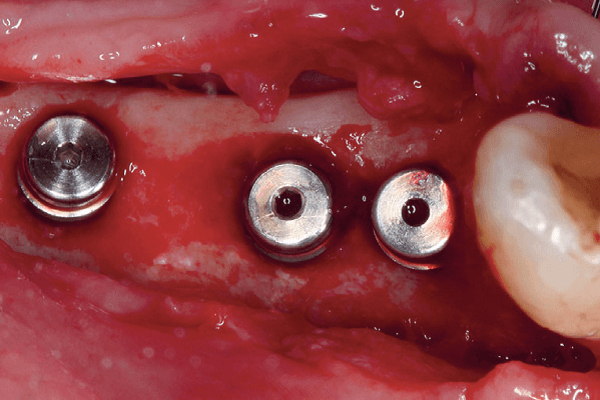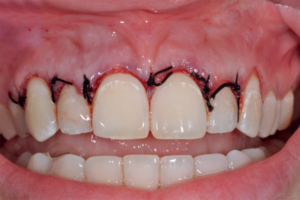RESUMO
Este trabalho descreve um caso clínico de implantes com diagnóstico de peri-implantite em região posterior de mandíbula. Após sua remoção, foi necessária a realização de regeneração óssea guiada usando a técnica de tela de titânio para ganho vertical e posterior instalação de implantes curtos. O uso das estruturas não absorvíveis, como as telas de titânio, possibilita melhores resultados em grandes reconstruções ósseas. O paciente foi tratado em duas etapas. Na primeira, foi realizada a remoção dos implantes contaminados e o aumento ósseo vertical com técnica da tenda, com instalação concomitante de um implante curto. Na segunda etapa, após seis meses, foi realizada a reabertura da região e instalação de mais dois implantes curtos. O uso de implantes curtos pode evitar reconstruções maiores, sendo desta forma extremamente vantajoso em casos como este descrito no trabalho.
Palavras-chave – Aumento ósseo; Tela de titânio; Implante curto.
ABSTRACT
This paper describes a clinical case of implants with a diagnosis of peri-implantitis in the posterior region of the mandible. After its removal, it was necessary to perform a guided bone regeneration using the titanium mesh technique for vertical augmentation and subsequent installation of short implants. The use of non-absorbable structures such as titanium mesh leads to better results in large bone reconstructions. The patient was treated in two stages. In the first stage, the removal of contaminated implants and vertical bone augmentation with the tent technique were performed, with the simultaneous installation of a short implant. In the second stage, after six months, the region was reopened, and two more short implants were installed. The use of short implants can avoid larger reconstructions and is therefore extremely advantageous in cases such as this described in the paper.
Key words – Bone augmentation; Titanium mesh; short implant.
Referências
- Schropp L, Wenzel A, Kostopoulos L, Karring T. Bone healing and soft tissue contour changes following single-tooth extraction: a clinical and radiographic 12-month prospective study. Int J Periodontics Restorative Dent 2003;23(4):313-23.
- Cawood J, Howell RA. Classification of the edentulous jaw. Int J Oral Maxillofac Surg 1988;17(4):232-6.
- Poli PP, Baretta M, Cicciù M, Maiorana C. Alveolar ridge augmentation with titanium mesh. A retrospective clinical study. Open Dent J 2014;8:148-58 (DOI: 10.2174/1874210601408010148).
- Sakr AA, Shaaban AM, Elsheikh AS. Evaluation of the effect of i-gen titanium membrane around immediate dental implants replacing posterior mandibular tooth with buccal bone defect. Alex Dent J 2017;42(1):85-91.
- Hammed MH, Gui M, Ghafoor R, Khan FR. Vertical ridge gain with various bone augmentation techniques: a systematic review and meta-analysis. J Prosthodont 2019 Feb 4
- Louis PJ, Gutta R, Said-Al-Naief N, Bartolucci AA. Reconstruction of the maxilla and mandible with particulate bone graft and titanium mesh for implant placement. J Oral Maxillofac Surg 2008;66(2):235-45.
- Stenport VF, Ortorp A, Thor A. Onlay and inlay bone grafts with platelet-rich plasma: histologic evaluations from human biopsies. J Oral Maxillofac Surg 2011;69(4):1079-85.
- Her S, Kang T, Fien MJ. Titanium mesh as an alternative to a membrane for ridge augmentation. J Oral Maxillofac Surg 2012;70(4):803-10.
- Louis PJ, Gutta R, Said-Al-Naief N, Bartolucci AA. Reconstruction of the maxilla and mandible with particulate bone graft and titanium mesh for implant placement. J Oral Maxillofac Surg 2008;66(2):235-45.
- Corinaldesi G, Pieri F, Sapigni L, Marchetti C. Evaluation of survival and success rates of dental implants placed at the time of or after alveolar ridge augmentation with an autogenous mandibular bone graft and titanium mesh: a 3- to 8-year retrospective study. Int J Oral Maxillofac Implants 2009;24(6):1119-28.
- Fontana F, Maschera E, Rocchietta I, Simion M. Clinical classification of complications in guided bone regeneration procedures by means of a non resorbable membrane. Int J Periodontics Restorative Dent 2011;31(3):265-73.
- Miyamoto I, Funaki K, Yamauchi K, Kodama T, Takahashi T. Alveolar ridge reconstruction with titanium mesh and autogenous particulate bone graft: computed tomography-based evaluations of augmented bone quality and quantity. Clin Implant Dent Relat Res 2012:14(2):304-11.
- Nisand D, Picard N, Rocchietta I. Short implants compared to implants in vertically augmented bone: a systematic review. Clin Oral Implants Res 2015;26(suppl.11):170-9.
- Appleton RS, Nummikoski PV, Pigno MA, Cronin RJ, Chung KH. A radiographic assessment of progressive loading on bone around osseointegrated implants in the posterior maxilla. Clin Oral Implants Res 2005;16(2):161-7.
- Boyne PJ, Cole MD, Stringer D, Shafqat JP. A technique for osseous restoration of deficient edentulous maxillary ridges. J Oral Maxillofac Surg 1985;43(2):87-91.
- Roccuzzo M, Ramieri G, Spada MC, Bianchi SD, Berrone S. Vertical alveolar ridge augmentation by means of a titanium mesh and autogenous bone grafts. Clin Oral Implants Res 2004;15(1):73-81.
- Retzepi M, Donos N. Guided bone regeneration: biological principle and therapeutic applications. Clin Oral Implants Res 2010;21(6):567-76.
- Her S, Kang T, Fien MJ. Titanium mesh as an alternative to a membrane for ridge augmentation.
J Oral Maxillofac Surg 2012;70(4):803-10. - Gutta R, Baker RA, Bartolucci AA, Louis PJ. Barrier membranes used for ridge augmentations: is there an optimal pore size? J Oral Maxillofac Surg 2009;67(6):1218-25.
- Torres J, Tamini F, Alkhraisat MH, Manchón A, Linares R, Prados-Frutos JC et al. Platelet-rich plasma may prevent titanium-mesh exposure in alveolar ridge augmentation with anorganic bovine bone. J Clin Periodontol 2010;37(10):943-51.
- De Santis D, Cucchi A, Rigoni G, Longhi C. Short implants with oxidized surface in posterior areas of atrophic jaws: 3- to 5-year results of a multicenter study. Clin Implant Dent Relat Res 2015;17(3):442-52.
- Malchiodi L, Cucchi A, Ghensi P, Consonni D, Nocini PF. Influence of crown-implant ratio on implant success rates and crestal bone levels: a 36-month follow-up prospective study. Clin Oral Implants Res 2014;25(2):240-51.
- Pohl V, Thoma DS, Sporniak-Tutak K, Garcia-Garcia A, Taylor TD, Haas R et al. Short dental implants (6 mm) versus long dental implants (11-15 mm) in combination with sinus floor elevation procedures: 3-year results from a multi-center, randomized, controlled clinical trial. J Clin Periodontol 2017;44(4):438-45.





